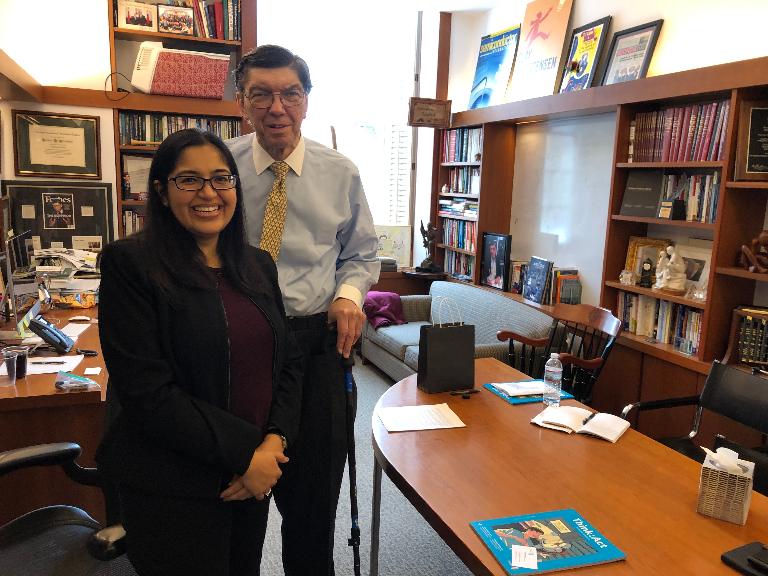

creative.
Neelima: Remembering Clayton Christensen - The man who changed how we see disruptive innovation
From my base in Hong Kong, I oversee Roland Berger’s management magazine, Think:Act. I have a keen interest in management thought. Over a career spanning two decades, I have interviewed several thought leaders like C.K. Prahalad, Michael Porter, Philip Kotler, Clayton Christensen, Henry Mintzberg, Henry Chesbrough, Marshall Goldsmith and Gary Hamel, and Nobel Prize winners John Nash and Amartya Sen.
It was July 2005 and it was my second day at The Times of India in Mumbai. We had just learnt that Harvard Business School professor Clayton Christensen was in town and speaking at an event later that day. “You should go and interview him,” said my editor Indrajit Gupta (IG as we all call him).
The name Christensen was on everyone's lips in those days. Every second business leader you met in India was talking of his ideas. Christensen first shot to fame with his 1997 book The Innovator’s Dilemma. The book laid out for the world the famous disruptive innovation theory. In simple terms, disruptive innovation describes how products or services can start off at the bottom of the market—a segment that large, well-entrenched players usually ignore—and then quickly move up the market, posing a serious threat to established competitors. The theory, which shed new light on a lot of existing market phenomena, proved to be wildly successful and made Christensen something of a rock star. Business leaders, from Intel's Andy Grove to Apple's Steve Jobs, started revering Christensen. He followed up The Innovator's Dilemma with books like The Innovator's Solution and then Seeing What’s Next, a book that aimed to help decision-makers predict how their industries would evolve.
But I, a rookie reporter, hadn't read any of these books yet.

Nervous, I returned to my desk. I had only recently transitioned to writing about management and I wasn’t very familiar with any of Christensen’s theories. I couldn’t possibly read up everything within an hour and be ready with a sensible interview.
I looked outside the window. The downpour was incessant. The event was at a hotel close to the airport and we were at the other end of town. “Are you crazy?” said a colleague. “Cars are submerged in water there. You better not go anywhere.” I told IG. “Even better! No one else will manage to come. You can get an exclusive!” Better sense prevailed and I stayed put. I used the time instead to read up on Christensen’s work and set up the structure for a sensible interview. Meanwhile, I also emailed someone I knew in the communications team at Harvard Business School (HBS), formally asking for the interview.
The rain was relentless in Mumbai that day and water levels were rising dangerously. Local trains had stopped running and the roads were waterlogged. We would soon head into what would later be known as 26/7, the worst floods the city had experienced till then. By now my contact at Harvard had emailed Christensen requesting him to meet me if he had the time.
That night none of us could go home. The Times magically arranged for bedding for a building full of employees. And soon my colleagues had all gone off to sleep. I, however, couldn’t. It was only my second day here and I was too embarrassed to sleep in office. I spent the night hunched up on my computer even as the editor-in-chief’s secretary routinely implored me to go to bed.
It was then the email came:
“Hello Neelima,
Thank you very much for your interest in interviewing me. I am in Mumbai; however, I'm not sure for how much longer I will be here. We haven't been able to get back to our hotel due to the rain. When we do get back, time permitting, I will give you a call on your mobile.
Thanks again!
Clayton Christensen”
That was it! By now I was too excited to sleep. By midnight, I was reading my umpteenth article on Christensen, and had exchanged a few emails with him already. His event had been cancelled and by then, he had, it seems spent quite some time in a car stuck on the road, watching the water levels rise perilously around the car. At some point, the organisers of the event he had come for gave up trying to get him back to his hotel, the Taj Hotel in Colaba, and checked him into a hotel near the airport.
He promised to write to me again once he knew what his schedule looked like. Comfortable in the thought that this was not a flat “no”, I finally went to sleep.
The next day was a blur. We woke up in office unsure if we could go home. Trains were still not working but the rain had stopped. Meanwhile, it was rumoured that food supplies would run out at noon. At around 11 am a couple of colleagues and I bravely decided to go home. A cab got us one-third of the way and we walked the rest of the distance. Seven hours later I was home and exhausted. There were new problems to deal with at home: a damaged car, wrecked elevators making the climb to our 10th storey flat an effort for tired legs, and rotten food because there had been no electricity now for 30 hours. Christensen was the last thing on my mind now.
I slept for 10 hours straight that night, my mind still a blur and my body hurting. And then my phone rang. It was Christensen. All his meetings had been cancelled due to the floods and would I care to meet him? I jumped at the idea. He had all the time in the world now and it was up to me to take it.
“Yes, I would love to!” I said.
“Sure, come over then,” he said.
“Where will I find you?” I asked.
“I will wait for you in the lobby. You can’t miss me—I am 6’8”,” he said.
I smiled. I quickly got ready and made my way to the Taj. And sure enough, he was there in the lobby waiting for me. I had never seen anyone this tall before. We shook hands—I still recall how my hand vanished into his giant hand. He was relaxed and quite at ease, despite having been on quite an adventure in the last 24 hours.
Interviewing thought leaders in management, especially as a newbie, can be intimidating. You are forever conscious that you know so little compared to the person in front of you and the pressure to talk intelligently is intense. I had been in some such situations before but with Christensen it was different. He never once made me uncomfortable. He took his time to discuss every answer in great detail, even taking my notebook to draw little graphs. I was hanging on to every word. The interview was not on my mind anymore—I was learning. Learning from a scholar most people wouldn’t have access to. In the two hours I spent with him that day I learnt more than I would have in a year in a real classroom.
We talked about what would be the building blocks of the ‘jobs to be done’ theory, the problem with data, and new ways in which marketers should look at customers. There was one thing that stayed with me from that interview, a strand that has been through all of Christensen’s work through the decades. “The problem with data is that it is only available about the past. So if you wait until the data can clearly tell you what to do, almost always you have missed the opportunity to take action in a timely way,” Christensen told me. “The only way that you can interpret if something happens in your environment, the only way you can impute meaning to that observation is through the laws of theory.”
That’s what he was attempting to do: develop a body of theories about management that allow you to pick up each theory “like a set of lenses” and look at something that is happening in the industry today and predict what that would result in going forward. He also lamented how a lot of managers didn’t “give credence to the word ‘theory’ because it is associated with the word ‘theoretical’ which denotes it’s not practical”.
I came back to the office feeling charged up and hammered out the interview within two days.
And then he went back.
But before he returned he sent an email to my contact at HBS:
“Dear David:
We had a good conversation. She’s a very, very sharp, impressive woman, and asked great questions that showed unusual understanding of the issues. Thanks to both of you for this opportunity.
-Clay C."
I was mildly shocked. And then pleased. Until now I was a bit unsure of whether writing on management was really my calling. This sealed it, and I would go on and build a career in this niche.
- Who is a disrupter?
That first encounter made Christensen one of my favourite interviewees, and I kept in touch regularly. Story on innovation? Mail Christensen. Something happening at TCS? Ask Christensen who was on the board. HBS is looking for a new dean, possibly Indian? Ask Christensen. He replied graciously every time but never ever divulged any secrets.
I met him whenever he came to India and each interview would yield a spectacular new insight. On one such visit, I noticed his smile suddenly melt and his face turn pale. Interrupting our interview, he said, “I need something sweet. I am diabetic and my sugar levels have dipped.” We quickly rushed to a restaurant but he started looking worse and worse. I panicked. What would I do if he collapsed suddenly? The bewildered waitress at the restaurant heard me out and quickly got us three cubes of sugar. Christensen’s face turned red. He was trying his best not to show his disappointment, perhaps anger. This was the first time I had ever seen him ruffled. Clearly, he needed more than just a few cubes of sugar. I told him to sit down while I ran to the hotel patisserie and got him a big chunk of Black Forest cake. As he ate it, he slowly came back to his usual self. I lingered on, a little unsure of what to do next. But he smiled his big Christensen smile and said we should restart the interview. He completed the interview as if nothing had happened. That was Christensen for you.
While much of the business world was in awe of him, Christensen attracted his share of detractors as well, albeit a small number. The most prominent one being Harvard history professor Jill Lepore. Lepore wrote a damning article in The New Yorker with the subtitle “What the gospel of innovation gets wrong” and accused him of presenting a theory on the foundations of shaky evidence. “Disruptive innovation as a theory of change is meant to serve both as a chronicle of the past (this has happened) and as a model for the future (it will keep happening). The strength of a prediction made from a model depends on the quality of the historical evidence and on the reliability of the methods used to gather and interpret it. Historical analysis proceeds from certain conditions regarding proof. None of these conditions have been met,” she wrote.
This time, the usually calm and collected Christensen quickly rose to defend his theory in Bloomberg BusinessWeek. Apparently, he even waited outside Lepore’s office hoping to discuss this with her. I’m not sure what that resulted in.
The problem perhaps lay with how the term disruptive innovation has been used. Over the years, disruption has become a much bandied about term. Every new and successful company is labelled a disrupter. Eventually, Christensen felt compelled to clarify this—again. So, in the pages of Harvard Business Review, he wrote an article titled ‘What is Disruptive Innovation?’ 18 years after he published his seminal book. “Unfortunately, disruption theory is in danger of becoming a victim of its own success. Despite broad dissemination, the theory’s core concepts have been widely misunderstood and its basic tenets frequently misapplied. Furthermore, essential refinements in the theory over the past 20 years appear to have been overshadowed by the popularity of the initial formulation. As a result, the theory is sometimes criticized for shortcomings that have already been addressed,” he wrote. And Uber, he categorically clarified, is not a disrupter.
- What kind of person do you want to be?
A few years went by. I left India for the US for a fellowship and subsequently found myself in Beijing and then Hong Kong. We lost touch. I tried getting back in touch, but now my mails would go unanswered. I tried his super-efficient assistant. She would tell me his schedule is too full—every time.
It was only much later that I would discover the reason for his evasiveness: in 2007 he had a major heart attack, in 2009 he was diagnosed with cancer, and in 2010 he had a stroke. Three life-altering events, one after the other. These events took a toll on him. But, this was Christensen, someone Forbes magazine would put on the cover in 2011 with the words “The Survivor” splashed across in big font. Unfazed and unbroken, he approached his ailments differently—with analytical precision. He learnt how to manage his condition. He also analysed how the health care system worked, and how it needed to change.
One of the worst things was the stroke which robbed him of his ability to speak.
As his son Matthew would tell Forbes, Christensen bought himself Rosetta Stone English and started learning words all over again: “He’d have contests with my oldest daughter, Madeleine [6 years old]. He lost a lot.” He taught himself how to speak again and over time he returned to his teaching.
It was in 2010 that Christensen turned his strategy viewfinder from business to life. In 2010, he addressed the graduating class at HBS on how they could apply his principles to their personal lives. In a world where everyone is struggling to find meaning, that lecture touched a chord. It led to an article in Harvard Business Review and then a book titled How Will You Measure Your Life? (with Karen Dillon and James Allworth). As he told Fast Company: “I believe that we can, in a deliberate way, articulate the kind of people we want to become. We can articulate the culture that we would want to exist in our family, and you can then, as the rest of life happens to you, you can utilize those things to help you become the kind of person you want to be.” The book, which was at its heart a guide to life, had a tremendous impact on readers and showed to the world that Christensen thought deeply about things other than business too. Today if one were to look at Christensen’s most influential ideas, How Will You Measure Your Life? stands toe to toe with disruptive innovation.
- A teacher's legacy
A few more years passed. I changed jobs and moved to Hong Kong. Work would take me to Boston off and on and it felt weird going to HBS and not trying to meet Christensen. So I tried emailing again. Things had changed again, clearly. Now emails would generate an auto response asking you to fill a form regarding the purpose of the meeting. I did. It vanished into a black hole.
But I also had other meetings at HBS. As I was waiting to meet another professor at Morgan Hall, the building where Christensen’s office was, I saw him coming towards me. I was shocked to see him. He had lost a lot of weight and was walking with the help of a stick. He graciously said hello and walked past me. It was quite obvious he did not recognise me. It was then I realised how much he had been through over the years.
But clearly he wasn’t done yet. He wrote another book, with Efosa Ojomo and Karen Dillon, titled The Prosperity Paradox. There are different shades of innovation—sustaining innovations (that make a good product better), efficiency innovations (that make a good product cheaper) and market-creating innovations (that make products simple and affordable so more people can access them). The book makes a strong argument for how market-creating innovations can lift entire nations out of poverty, a better alternative to aid.
Perhaps things improved a bit because I saw Christensen’s name as a speaker at a management conference I was going to attend. I got in touch with my friend in communications at HBS and asked him if I should even attempt requesting him for an interview—now that I had seen how Christensen was, was it even appropriate to ask? My friend replied positively, and in fact, walked over to Christensen’s office and requested his assistant to help with my request. Things started moving again but Christensen cancelled his engagement at the conference, presumably due to another health episode.
Two months later work took me to Boston again. I nudged my friend who confirmed that things were better and I could try for an interview again. His assistant confirmed. About an hour before the interview she emailed saying Efosa Ojomo would join us because Christensen sometimes has trouble with words due to his stroke.
And so I walked into his room and met both him and Ojomo. He had clearly no recollection of who I was and I thought it best to not remind him, given the tight time slot. Before we began, he told me he would have to keep walking as we talked because of a neurological issue he had developed. It’s then I realised this would be harder than I had imagined. We began the interview. Christensen would start answering my questions but he would often stumble over a word. Then he would nudge Ojomo to complete the answer, which he would brilliantly, not a word out of place. In short, just as Christensen would have answered it. Clearly, articulation was a big issue, but the logic and clarity were still there in his mind. Christensen was not having the best day, physically. He struggled to open a can of soda and pour it, as we both looked on concerned. Eventually Ojomo helped him. We somehow finished the interview, and as I got ready to leave, he looked at my business card and said: “Your name is familiar. Have we met before?”
I said yes, and reminded him of our first meeting. He had not forgotten Mumbai’s torrential rain. “Oh Efosa,” he said to Ojomo with a twinkle in his eye, “the water was up till here.” He gestured at his waist.
We talked a little more before I left, and it hit me somehow that this might be the last time we meet. I knew I wouldn’t be asking him for an interview again. It just wouldn’t be right.
It seems he also knew he didn’t have much time left, even though there was still a lot more his brilliant mind had to offer. His mind was still brimming with ideas and he prepared several others—like Ojomo, a brilliant thinker and speaker in his own right—to pick up on his work from where he left off.
This article was first published on FoundingFuel




